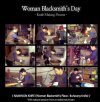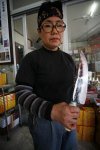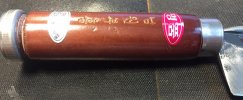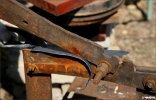I still haven't had a chance to use this thing yet, but the wife used it to make some stew. Here's her in-depth review: "good knife, cuts good."
I think the T-spine is either a byproduct of the way they're forged or it's to give you a thick spine to put your thumb on while still keeping the thin blade. I can see how it might cause problems cutting hard root vegetables, but the wife apparently used it on potatos without any problems. The T doesn't stick out that far anyways. I'll have to try it myself.
No idea how long the tang is, will have to test it with a magnet. But it isn't peened to the pommel, there aren't any pins and the handle feels hollow so it can't be glued in there. But while it feels light it does seem sturdily built. It doesn't rattle or wiggle or anything. And this is the "premium" version, the regular one has a plain wooden dowel for a handle. So you'd figure it must be better than that.
As far as the garlic crusher goes, I think the thing is sturdy enough to crush a clove of garlic. I wouldn't use it to split a coconut or anything.
Another observation: the blade doesn't appear to rust! My wife always leaves my carbon steel blades wet and they end up looking they were dredged out of a swamp after one or two uses, but this one doesn't seem to be staining or rusting at all. My theory is that the edge is carbon steel but it's clad in low carbon soft iron from railroad ties. Sanmai construction. Or maybe the whole thing is made from low carbon iron and it won't hold an edge. Time will tell.
I read there's been a resurgence in traditional kitchen knifes in Korea. The art almost died out during the Japanese occupation and after that they mostly used Japanese or German knives. But a few years ago a Korean Soap opera came out about a chef working in a palace a few hundred years ago, and the creators had traditional Korean knives made for props. The show was hugely popular and Koreans became interested in their traditional cooking implements again.
Anyways, I still wouldn't be comfortable recommending these knives until I see how durable they are. Between me and the wife we'll surely break the thing if it isn't durable.












